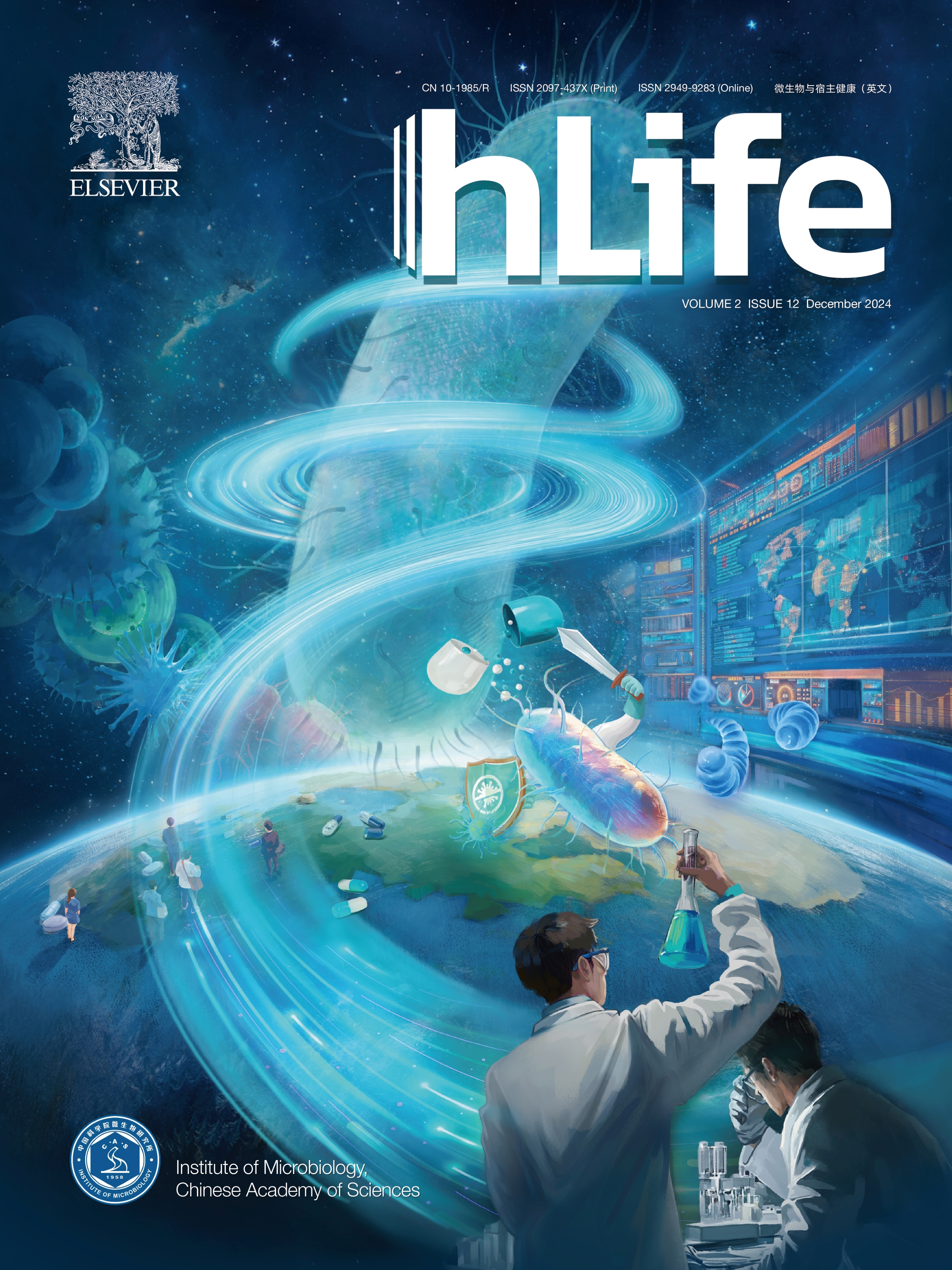博文
[转载]hLife 2024年第十二期正式出版
||


封面解读

肖永红
Antimicrobial resistance (AMR) is a major global public health issue, causing significant damage to global health and the economy. In 2024, the World Health Organization (WHO) released an updated version of the Bacterial Priority Pathogens List (BPPL), including carbapenem-resistant Klebsiella pneumoniae (CRKP). In recent years, there has been a growing identification of K. pneumoniae strains that integrate hypervirulence (hv) and CR phenotypes, resulting in severe clinical outcomes. Highly variable genomes caused by point mutation, recombination, and transfer of mobile genetic elements are the key factors underlying the epidemic success of CRhvKP. To address the drug-resistant bacteria, there is a need for increased policy and financial investment, optimized resource allocation, strengthened development of pathogen resistance surveillance systems, and real-time global information sharing. This cover page underscores the significant challenge of addressing AMR, yet it also emphasizes that through concerted global efforts, we can improve our preparedness and effectiveness in tackling this threat in the future.
All Papers
点击文章标题可阅读原文
1.WHO sed bacterial priority pathogens list to encourage global actions to combat AMR
通讯作者:肖永红

The World Health Organization (WHO) has updated its Bacterial Priority Pathogens List (BPPL) for 2024 to combat antimicrobial resistance (AMR), focusing on "One Health" criteria such as treatability, mortality, and resistance trends. The list categorizes pathogens as critical, high, or medium priority, emphasizing the need for new antimicrobials. Notable inclusions are carbapenem-resistant Acinetobacter baumannii (CRAB), carbapenem-resistant Enterobacterales (CRE), and third-generation cephalosporin-resistant Enterobacterales (3GCRE). The AMR crisis, especially with multidrug-resistant gram-negative bacteria, persists, highlighting the urgency for global action, investment, and R&D in diagnostics and therapeutics.

引用:
Ma Y, Chen P, Mo Y, et al. WHO revised bacterial priority pathogens list to encourage global actions to combat AMR.hLife2024; 2: 607–610.
hLife | 破解耐药高毒力肺炎克雷伯菌:毒力因子与进化机制揭秘
通讯作者:肖永红

本文系统阐述了耐碳青霉烯类高毒力肺炎克雷伯菌的重要毒力因子和进化整合的多种机制。

引用:Chen T, Ying L, Xiong L, et al. Understanding carbapenem-resistant hypervirulentKlebsiella pneumoniae: Key virulence factors and evolutionary convergence.hLife2024; 2: 611–624.
通讯作者:华兆林,侯百东

Highlights
Examining the severe acute respiratory syndrome coronavirus 2 (SARS-CoV-2)-specific B cell response allows for a comparison of vaccines in various formats.
The nanoparticle and mRNA vaccines exhibit superior immunogenicity compared with inactivated and recombinant protein vaccines.
Despite inducing a robust germinal center response, the mRNA vaccine elicits a limited number of memory B cells.

引用:
Guo C, Chai X, Baerlike M, et al. Comparison of antigen-specific B cell responses reveals disparity in immunogenicity and memory B cell formation across COVID-19 vaccine platforms. hLife 2024; 2: 625–640.
4. De novo design of covalent bonding peptides for target protein
通讯作者:周小红,王奇慧,Lip Ket Chin

Highlights
A two-step de novo design of covalent bonding peptides for target protein was established.
The reactivity of chemically modified peptides against their target was predicted using a modified Amber ff14SB force field.
Two designs blocked Omicron BA.2 pseudovirus infection with half maximal inhibitory concentrations of 1.07 μM and 1.56 μM.

引用:
Zhou X, Zhu Q, Zheng A, et al. De novo design of covalent bonding peptides for target protein. hLife 2024; 2: 641–652.
通讯作者:陈蓉,徐颖,张水军

This study presents the high-resolution structure of HCoV-HKU1A RBD bound to human TMPRSS2 receptor, which reveals the structural basis for the specificity of receptor binding by HCoV-HKU1. The interface between HCoV-HKU1 RBD and receptor also provides information for the development of vaccines and antivirals against HCoV-HKU1.

引用:
Wang W, Guan J, Ren M, et al. High-resolution crystal structure of human coronavirus HKU1 receptor binding domain bound to TMPRSS2 receptor. hLife 2024; 2: 653–657.
6. Myeloid cell diversity: From fundamental biology to disease states
通讯作者: Iván Ballesteros, Lai Guan Ng,
Daniela F. Quail, Andrés Hidalgo

The Keystone Symposia conference on Myeloid Cell Diversity, held in Canada, aimed to advance understanding of myeloid cell behavior in health and disease. The conference covered topics from phagocytosis of dead cells to myeloid cell states in disease and aging, fostering multi-disciplinary dialogue. Keynotes included imaging studies of neutrophil behavior, myelopoiesis strategies, and the impact of lifestyle on tumor immunity. The meeting also addressed myeloid metabolism's role in immunotherapy, highlighting the significance of myeloid cell diversity in fundamental biology and disease states.
引用:Ballesteros I, Ng LG, Quail DF, et al. Myeloid cell diversity: From fundamental biology to disease states. hLife 2024; 2: 658–660.
期刊简介
hLife由高福院士、董晨院士和Jules A. Hoffmann教授(2011诺奖获得者)领衔,是中国科学院微生物研究所主办,中国生物工程学会,浙江大学陈廷骅大健康学院,西湖大学医学院,上海市免疫治疗创新研究院和广州霍夫曼免疫研究所联合支持,与国际出版商爱思唯尔合作的健康科学领域综合性英文期刊。
hLife聚焦健康科学领域的前沿进展,旨在促进基础研究与临床应用的融合发展。期刊发表与医学相关各研究领域最新成果,学科领域包括(但不限于)病原生物学、流行病学、生理学、免疫学、结构生物学、疾病监测、肿瘤、药物、疫苗和健康政策等。
hLife是一本金色开放获取期刊,月刊出版;2022年成功入选“中国科技期刊卓越行动计划高起点新刊”;2023年11月正式创刊; 2024年5月被DOAJ收录;2024年8月被Scopus收录。
2026年前hLife接收的稿件免收文章处理费(APC)。
期刊网址:
https://www.sciencedirect.com/journ
https://blog.sciencenet.cn/blog-3552961-1466613.html
上一篇:[转载]hLife恭祝各位老师圣诞节快乐!新年快乐!